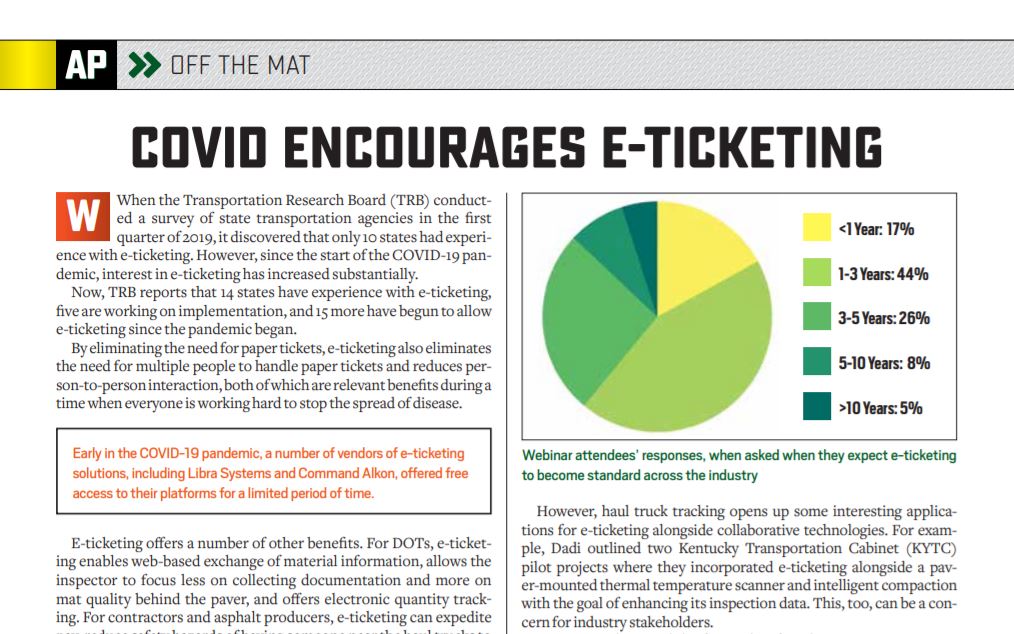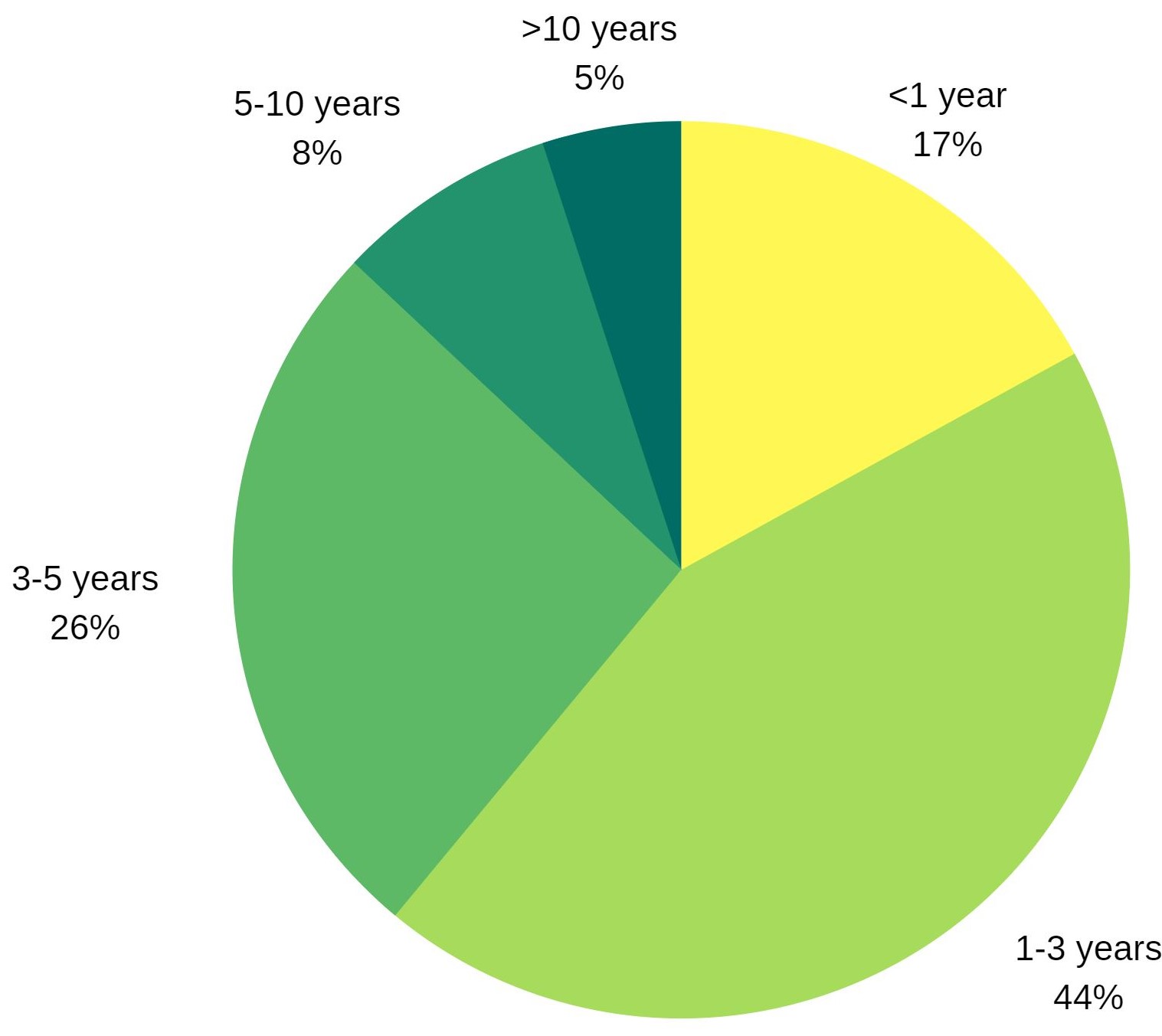COVID Encourages E-Ticketing
BY AsphaltPro Staff

When the Transportation Research Board (TRB) conducted a survey of state transportation agencies in the first quarter of 2019, it discovered that only 10 states had experience with e-ticketing. However, since the start of the COVID-19 pandemic, interest in e-ticketing has increased substantially.
Now, TRB reports that 14 states have experience with e-ticketing, five are working on implementation, and 15 more have begun to allow e-ticketing since the pandemic began.
By eliminating the need for paper tickets, e-ticketing also eliminates the need for multiple people to handle paper tickets and reduces person-to-person interaction, both of which are relevant benefits during a time when everyone is working hard to stop the spread of disease.
Early in the COVID-19 pandemic, a number of vendors of e-ticketing solutions, including Libra Systems and Command Alkon, offered free access to their platforms for a limited period of time.
E-ticketing offers a number of other benefits. For DOTs, e-ticketing enables web-based exchange of material information, allows the inspector to focus less on collecting documentation and more on mat quality behind the paver, and offers electronic quantity tracking. For contractors and asphalt producers, e-ticketing can expedite pay, reduce safety hazards of having someone near the haul trucks to collect tickets, and, depending on the platform selected, assist with managing and tracking haul trucks.
Despite these benefits, respondents to the TRB survey reported that pushback from haul companies, suppliers and contractors were three of the top five most significant challenges to widespread e-ticketing adoption, alongside connectivity and cost. During a recent webinar presented by TRB, contributors to the NCHRP Synthesis Report 545 on e-ticketing Assistant Professor at Iowa State University Roy Sturgill and Associate Professor at University of Kentucky Gabe Dadi, shared their thoughts on some of the challenges facing e-ticketing adoption.

Webinar attendees responses, when asked when they expect e-ticketing to become standard across the industry
One of the more prevalent concerns with e-ticketing relates to data ownership and how data will be used in the future.
“We have to determine at what point throughout the process the state transportation agency owns the material,” Dadi said, “because that may control what data is available to who at what time.”
For example, Sturgill continued, there have been concerns about state agencies knowing the locations and speeds of haul trucks. “Is it appropriate for the DOT to let a supplier know how fast haulers are traveling?” he asked. For these reasons, Sturgill said there has been a move toward e-ticketing solutions without hauler tracking. One example is DOTslip, which AsphaltPro covered in our May 2020 issue.
However, that introduces some challenges to state agencies, who must verify that the truck on the jobsite is the same truck as the one for which the e-ticket was issued. The Pennsylvania Department of Transportation is overcoming this challenge by attaching magnetic signs to the side of each haul truck for quick visual verification by the inspector on the job, Sturgill said. “Iowa is working toward putting cameras on the paver so that can be another option for verification that the truck pulling into the paver is the truck on the ticket,” he added.
However, haul truck tracking opens up some interesting applications for e-ticketing alongside collaborative technologies. For example, Dadi outlined two Kentucky Transportation Cabinet (KYTC) pilot projects where they incorporated e-ticketing alongside a paver-mounted thermal temperature scanner and intelligent compaction with the goal of enhancing its inspection data. This, too, can be a concern for industry stakeholders.
“Knowing where each load was placed in the pavement mat gives us the ability to do a lot in the future for pavement forensics,” Sturgill said. “But, we have to make it clear that it isn’t another ‘Gotcha!’ for the contractor.”
Dadi continued, “We have to put the industry at ease by letting them know that this is a data collection technique, and it’s not something we’re going to come back to them about.”
A lot of these concerns can be resolved by proactive communication with all stakeholders. “It’s important that all partners, contractors and suppliers sit down and have these conversations before they dive into a project,” Sturgill recommended. Dadi also added the importance of bringing your chosen vendor on board early.
“We’re also seeing a rapid increase of vendors in this space,” Sturgill said. “Vendor competition continues to grow and as time passes, costs will continue to fall.”
Vendors have also become a primary topic of discussion in regards to e-ticketing lately, Dadi said, as the industry looks to standardize e-ticketing data so it’s possible to transfer data to DOTs regardless of vendor.
“We’re not there yet, but it’s something that is coming,” Dadi said. “In the meantime, work with your vendor to ensure you get the info you need for your state.”
At the end of the webinar, attendees were surveyed about their own outlook on e-ticketing adoption. More than 60 percent said they expected e-ticketing to become standard within the next three years. One quarter estimated three to five years, 8 percent estimated five to 10 years, and only 5 percent reported that they thought e-ticketing wouldn’t become standard within the next decade.
“COVID-19 has drastically impacted e-ticketing,” Sturgill said. “We’re seeing rapid implementation and some of the barriers of the past have seemed to fade away.”
